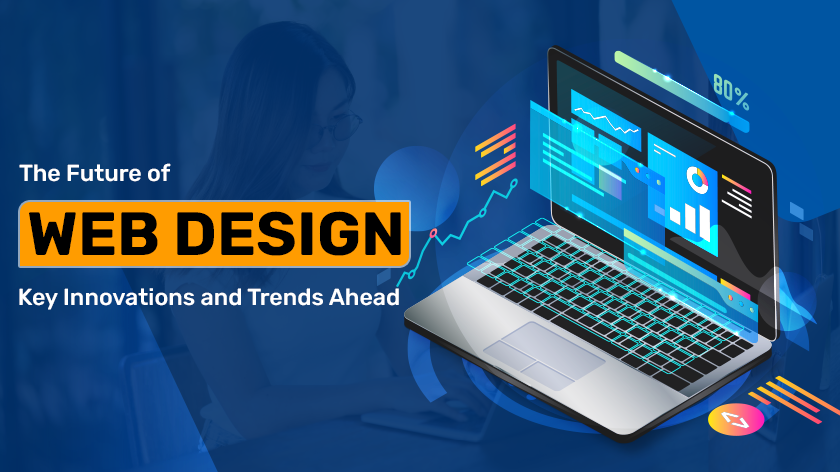Staying ahead of the curve in the ever changing field of web design is essential to producing visually appealing, interesting, and user-friendly websites. A number of emerging trends and technologies have the potential to completely transform how we develop and use the World Wide Web in the future. The following are some important developments and trends that impact web design in the future.
1. Integration of AI and Machine Learning
The fields of machine learning (ML) and artificial intelligence (AI) are rapidly influencing web design. Through the analysis of user behavior and preferences, these technologies allow websites to provide customized user experiences. For example, AI-powered chatbots improve user engagement by offering real-time customer service. AI solutions such as Adobe Sensei can also help designers by automating routine tasks and providing recommendations for designs based on data analytics.
2. Voice User Interface (VUI)
Voice User Interface, or VUI, is becoming an important component of modern web design with the rise in popularity of voice-activated assistants such as Alexa, Siri, and Google Assistant. By implementing VUI, users may engage with web pages via voice commands, offering an easy and hands-free browsing experience. This development is especially significant for accessibility, as it increases the online community’s inclusivity for individuals with disabilities.
3. Augmented Reality (AR) and Virtual Reality (VR)
The ways that people connect with digital information are changing as a result of AR and VR technologies. These technologies can be used in web design to produce immersive experiences like interactive instructional materials, virtual tours, and 3D product displays. Retailers of furniture, for instance, can improve online buying by using augmented reality (AR) to allow customers see how a piece might look in their house.
4. Progressive Web Apps (PWAs)
Progressive online Apps provide a smooth and quick user experience by combining the best features of online and mobile applications. PWAs are made to function offline, load quickly, and give users on mobile devices a native app-like experience. This technology is essential for increasing user retention and engagement, particularly in areas with inconsistent internet service.
5. Responsive and Adaptive Design
Although responsive design has long been the standard, attention is increasingly turning to adaptive design, which provides a more customised user experience by taking the user’s location, the device’s context, and other variables into account. Depending on the unique requirements of the user, adaptive design can offer several layouts and functionalities, guaranteeing a more customized experience.
6. Microinteractions
Tiny, delicate animations or design components known as microinteractions improve user interaction and offer feedback. A loading spinner or the animated “like” button on social media are two examples. These components can improve a website’s overall user experience by making it feel more responsive and interesting.
7. Minimalist and Dark Mode Design
Clean lines, lots of white space, and an emphasis on content are characteristics of minimalist design, which is still in style today. The desire for websites that load quickly and are easy to navigate is what is driving this trend. Furthermore, dark mode design is becoming more and more common, providing an aesthetically pleasing substitute that may reduce eye strain and increase battery life on OLED screens.
8. Advanced CSS and JavaScript
Designers may now produce more intricate and dynamic online animations and interactions thanks to new developments in CSS and JavaScript frameworks. Websites may now be made more interactive and engaging with the help of technologies like CSS Grid, Flexbox, and the newest JavaScript frameworks (React, Vue.js, Angular).
9. Sustainable Web Design
As environmental concerns grow, sustainable web design is gaining traction. This involves creating websites that are energy-efficient and have a lower carbon footprint. Techniques include optimizing images and videos, reducing unnecessary code, and implementing efficient hosting solutions. Sustainable design not only benefits the environment but also improves website performance and user experience.
10.Cybersecurity and Privacy
With increasing concerns about data privacy and security, web designers must prioritize building secure websites. Incorporating robust encryption, secure authentication methods, and compliance with data protection regulations (like GDPR) are essential practices. Ensuring that users feel safe and their data is protected is critical for maintaining trust and credibility.
Conclusion
The future of web design is brimming with exciting possibilities. By embracing these emerging trends and technologies, designers can create more engaging, efficient, and user-friendly websites. Staying updated with these innovations not only enhances the user experience but also sets a competitive edge in the ever-evolving digital landscape. As we anticipate tomorrow’s web design, it’s clear that the integration of advanced technologies and user-centered design principles will lead the way.
I’m part of XcelTec, let’s create the future of web design together! Contact us today.
For more information, visit our website: https://www.xceltec.com/
 :
https://www.xceltec.com/
:
https://www.xceltec.com/












